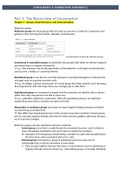CONSUMENT & MARKETING MIDTERM 2
Part 3: The Macro-View of Consumption
Chapter 7 – Groups, Social Processes, and Communications
Reference groups
Reference groups are those groups that are used by a person as a basis for comparison and
guidance when forming their beliefs, attitudes, and behaviors.
two dimensions to describe reference groups
Contractual or associative groups are generally close groups with which we interact regularly
and where there is a degree of proximity.
e.g., This closeness may be through family or friendship ties. or through mutual interests
such as work, a hobby, or a sporting interest.
Disclaimant group is one that we currently belong to or perhaps belonged to in the past but
no longer want to associate ourselves with.
e.g., At college, a person may be part of a social group that drinks alcohol, but if the group
then experiments with soft drugs, they may no longer join in with them.
Aspirational groups are composed of people that the consumer can identify with or admire
(often from afar) and aspires to be like in some way.
e.g., celebrities, influencers, sportsmen. Often the aspirational group is an individual
representing some state or position we aspire to be like.
Dissociative or avoidance groups are groups we have negative feelings towards and whom
we avoid being associated with.
They differ from disclaimant groups in that we have never been members of such groups,
and we associate negative feelings with them for their intrinsic qualities rather than because
we or they have changed.
Reference groups are also classified as formal or informal:
- Formal group is one that is usually formed by an outside structure, and it is likely to
have a formalized constitution and set of rules of conduct for members.
Examples of formal groups include being a member of a golf club and adhering to
the strict dress codes associated with such a club.
- Informal group is formed by a group of individuals who have some sort of
commonality but no formal connection to each other.
They may get together because they have a mutual interest (such as gardening or
singing), through common values (e.g., a boycotting group), or through friendship.
, CONSUMENT & MARKETING MIDTERM 2
Reference group influence
There are three main mechanisms of reference group influence:
1. Informational group influence is when a consumer uses the reference group to
actively get information from opinion leaders or expert groups.
E.g., We might purchase the same equipment as a celebrity cook or gardener.
2. Utilitarian reference group influence is when a person is influenced in their choice of
brand by the preferences of those with whom they socialize, including family
members and work colleagues.
E.g., When everybody in your family uses an iPhone, you will use one to.
3. Value-expressive influence is when someone buys a particular brand to enhance
their image and because they admire characteristics of people who use the brand.
Companies often develop ads, which link their brand visually with attractive
models or characters with a view to enhancing the image of their brand through
this connection.
Conformity can be defined as adoption of behavior resulting from real or perceived pressure
to comply with a person or group.
e.g., If you are with a group of friends and they all want to watch a football match, but
you would prefer to go shopping, you may conform to their decision because their friendship
is more important to you than going shopping.
There are four types of conformity:
1. Normative conformity applies when a person wants to fit in with the group or is
afraid of being rejected by them and will publicly accept the group’s view even if
privately, they do not agree.
2. Informational conformity occurs when someone actively looks for guidance from the
group where they lack knowledge or are in an ambiguous situation.
3. Compliance refers to publicly changing behavior to fit in with the group but privately
disagreeing, that is, a behavioral shift without an attitudinal one.
4. Internalization involves both an attitudinal and behavioral change in favor of the
group.
Reactance is a motivational state, which acts as a counterforce to threats to a person’s
freedom.
It can be a powerful force if groups of people feel that their freedom is compromised. E.g.,
social pressure to grieve for the death of Princess Diana.
Social power and reference groups
Social power is the degree of influence an individual or organization has among their peers
and within society.
- Reward power may be present when a person responds to the influence of the group
and is rewarded in some way.
- Coercive power means that conformity to the group is brought about through the
threat of punishment.
- Legitimate power is where the referent is seen to have authority by virtue of their
position in the context
Often achieved in service businesses by using uniforms to show authority.






